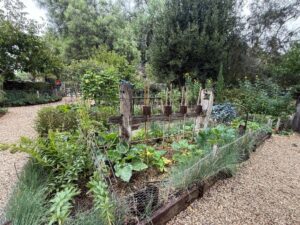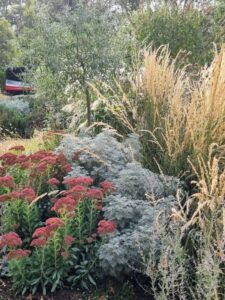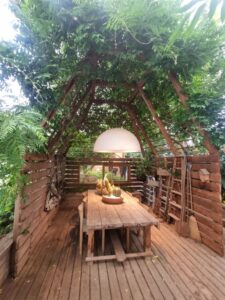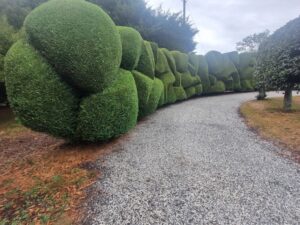
Exploring excellence: Visiting gardens of the Macedon region
By Patrick Regnault
Before the Australian Landscape Conference 2025 was held in Melbourne recently, Outlandish Ventures organised a tour of various gardens in the Mount Macedon region and the surrounding district. We visited five very different gardens, and each garden provided food for thought. The varied rainfall in which these gardens are located ranges from 600mm to 1200mm per year, and the current dry spell in this part of Victoria provides insight into how some significant areas of Australia may need to adapt their gardening practices.
Oak Cottage

A lovely 1900s weatherboard façade with a 100-year-old oak tree. The front garden is very large and user-friendly, featuring places to sit and dine, and is private yet not enclosed. The winding paths, dining, and seating areas, made from crushed granite, and the multi-level planting, anchor the garden and the house ideally within its larger environment. This cottage garden, designed by Tim Pilgrim, features a plant palette that reflects and contrasts beautifully with the surrounding bush.
Hanging Rock Garden
Situated near Woodend, with a view of the famous Hanging Rock, the garden, designed by Paul Bangay, surrounds a contemporary house and pool. The site was windy and had poor soil, which needed improvement. Lush lawns and plantings watered with the aid of four 250,000-litre water tanks contrast with the yellowed farmlands. The apple orchard provides a pathway to the wisteria-covered pergola, leading to the tennis court. The palette of greys, blues, and silvers, combined with the spring flowers of the orchard and the autumn colours of the trees, provides year-round interest.
Reverie
This garden, situated near Lyonville at an altitude of 750 meters, benefits from an annual rainfall of 1,200 millimetres per year. The 4.5-hectare farmland was transformed into a series of 13 chambers by Landscape artist Mel Ogden between 1995 and 2011. The property has had new owners since 2014, and the link with Ogden continues to this day. The head gardener, John Flynn, has enhanced the garden by sculpting the conifer hedges with a horticult-artist eye.
Daylesford Longhouse

This multi-award-winning building was a collaboration between Architects Partners Hill and the owners, Trace Streeter and Ronnen Goren. Situated at the Elevated Plains, with poor soil, high winds, very low rainfall, hungry wildlife, and significant temperature fluctuations, it is a very challenging site. On approach, what you see is a 110m-long industrial shed, and upon entering, you’re greeted with something truly phenomenal. Once past the wooden sliding doors, you enter a different world. The details and the finishes of the built environment inside are very close to perfection. It doesn’t have the feel of a greenhouse but rather the kindness of a garden house. Plants that would not survive a day outside thrive well. The well-appointed kitchen, lounge, bathroom, bedrooms, and sitting rooms are separated by very soothing green spaces. Outside the shed, a large vegetable garden planted in raised beds supplies the kitchen with healthy-looking vegetables.
The Stones

Historic buildings and a challenging environment in a rain shadow, with temperatures ranging from minus 7º to a scorching 47º. Yet, this is not just a building or a garden; this is a place where heart, beauty, and respect are at its core, a rare combination. Jeremy Valentine and Grant Francis bought the property nine years ago. Through trial and error, they developed the garden surrounding the buildings, which include a wattle-and-daub stable and a stone house built in 1845 by the first owners, Cornish miners. The property also features an Edwardian stucco dairy and a 1920s iron shed. Some original plantings from the early years of settlement, such as the walnut tree and some other fruit trees, remain. The planting around the building enhances their charm; the vegetable patch is a testament to their skill, and the cactus garden is strangely beautiful, even for the “cactusophobe” that I am.

The Big Tree
A late addition to the tour, this pit stop provided us with a glimpse of the magnificent Big Tree in Guildford. Aged between 500 and 1000 years old, this Eucalyptus camaldulensis is significant not only for its age but also for its cultural importance as a birthing tree to the Dja Dja Wurrung clans. The tree suffered damage from a storm in February 2024. The Council carried out remedial work following a meeting with representatives of the local Aboriginal corporation, DJAARA. Fallen timber and foliage were removed and distributed appropriately for re-use by the indigenous community.
Patrick Regnault FAIH RH0062
Interactive Landscapes
E: patrickregnault@hotmail.com
